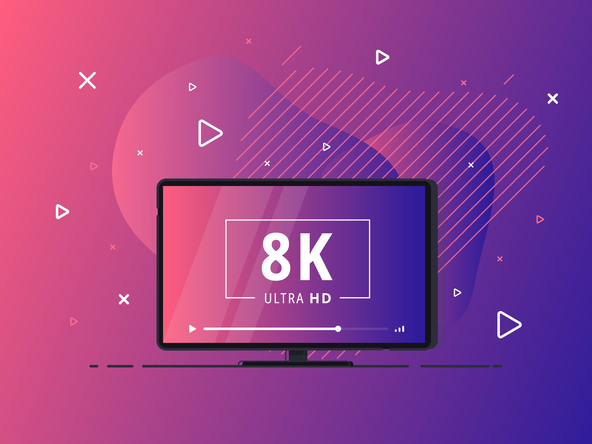Although I have been working in the AV industry for close to eight years, I still consider myself a consumer, not an expert, on AV technology. I know just enough not to take every new piece of tech at face value, or believe the hype from product marketing. This is where we as consumers or AV integrators need to make sure we’re educated, and not basing our purchases solely on what the sellers of the technology have told us. Sometimes what has been marketed is not always complete, accurate, or obtainable. It could be exaggerated specifications, glossing over of known glitches, shortcomings, or usage cases that are virtually impossible to recreate. It is important to get through all the marketing fluff and get to the meat of the technology. It’s also important to understand why a new technology is better, as well as where and if it fits into our homes and installations — all while educating ourselves in understanding the inherent weaknesses that every piece of technology has. With 8K visible everywhere and the full marketing push behind it, I’ve had some burning questions for my industry peers, and wanted some guidance on this technology and its future that I can share with the retail and CE professionals who read Dealerscope. Based on my conversations with engineers, manufacturers, salespeople, installers, and retailers, here is some of the information that I put together on this new 8K industry trend.
Only early adopters need apply.
When 4K was introduced to the custom integrator (CI) channel in 2013, 4K, at its best, could only support 4K/30Hz with 4:4:4, 8-bit HDR at 10.2 Gbps. While this was vastly superior to 1080p, the true benefits of 4K came from the embedded 10-bit HDR (High Dynamic Range) metadata. In order to support HDR-10, compression had to be added; the existing infrastructure couldn’t support 18 Gbps because category cables (CAT6a) maxed out at 10.2 Gbps. Remember that when you invest in anything 8K; we’re still at the beginning of the technology and what is possible remains limited. Take all the promises and hype with a grain of salt!
It’s all about the bandwidth.
Having a solid understanding of the bandwidth calculations of 8K and what 8K brings to the table is vital before investing or upgrading from current 4K products. True 8K requires significantly more bandwidth than its 4K counterpart. 8K products need to be able to support the minimum of 32.08 Gbps for 8K 30 Hz at 4:2:0, or, for full 8K 60 Hz 4:4:4, 80.19 Gbps is required. 8K/HDMI 2.1 also encompasses many benefits outside of resolution such as eARC, Fixed Rate Link, Auto Low Latency Mode, and Variable Refresh Rate, to name a few. Still, bandwidth must be looked at as a whole and depends on various factors from cable quality to broadband speed (for streaming). 40 Gbps for 8K is just a stepping stone for what is to come as we grow the technology. The HDMI.org website is a good source for the various factors that affect bandwidth.
Wait for updated chipsets.
In a rush to be first to market, many manufacturers have jumped on the “8K” bandwagon, but they’re doing so without testing equipment in real-world environments. As a result, most 8K products hitting the market today are only able to support up to 40 Gbps. They are finding out the hard way that the products they designed are not compatible with the actual sources. The experts I discussed this with don’t feel the current chip sets can deliver on the promises of true 8K. They’re waiting for the technology to reach a minimum of 48 Gbps (HDMI 2.1) before feeling secure in introducing 8K products to market.
Content in 8K is still minimal.
Right now, there isn’t much 8K content, which isn’t surprising considering that even true 4K content (with a horizontal resolution of 4,096 pixels) isn’t as widespread as we’d expect, considering the broad availability of 4K televisions and projectors. That said, 8K is available in limited ways, and the best way to get that 8K content at the moment will be through streaming. Sporting events in some regions (mainly Japan) are broadcasting live events in 8K, YouTube has some 8K videos created by its users, and both PlayStation 5 and Xbox Series X offer 8K gaming. I see the biggest opportunity for 8K being in live events at sports stadiums and concert venues.
The visual benefits of 8K are best experienced on gargantuan screens.
Can the human eye even see 8K? Yes AND no. 8K gives four times the horizontal and vertical resolution of 1080p and resolution does matter. However, to really make full use of 8K, you need to consider the screen size and viewing distance. For an average viewer with 20/20 vision sitting 10 feet away from the screen, to be able to see a visible difference between 4K and 8K, the screen should be around 280 inches! The bigger the screen and further viewing distance, the better the 8K will look to you. This suggests that projectors may be the way to go to create visible 8K benefits at home. It also creates huge opportunities for 8K in live events, sports stadiums, and concert venues. 8K is breathtaking with large displays, even with viewers sitting far away. Personally, I’m ready to go sit at Fenway Park (apologies to any Yankees fans) in my normal nosebleed seats and look out to the stadium displays showcasing my favorite team in 8K popping off the screen.
Now that technology has reached the 8K benchmark, it’s important for both retailers and consumers to make educated decisions about buying and selling. Understanding the technology is the best way to ensure you get all the benefits that 8K can currently provide.















